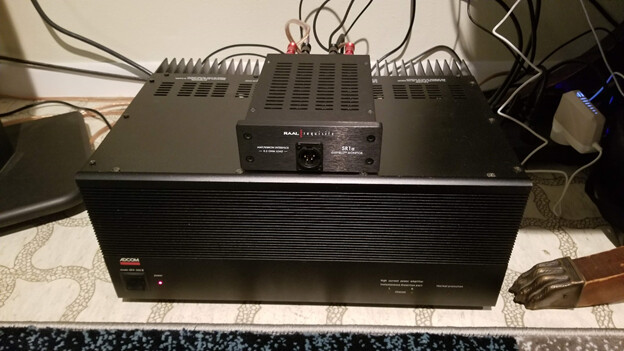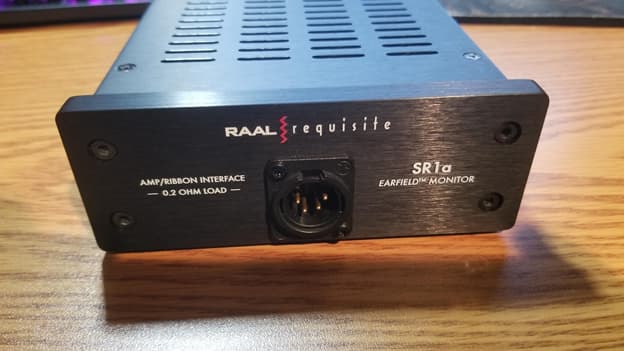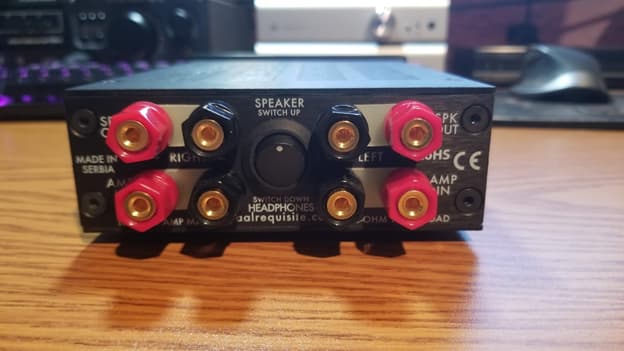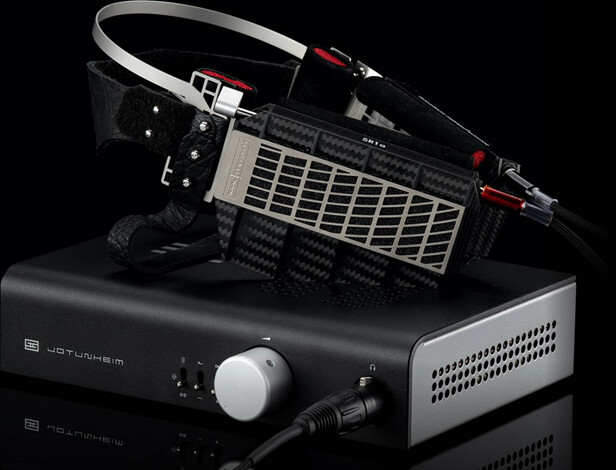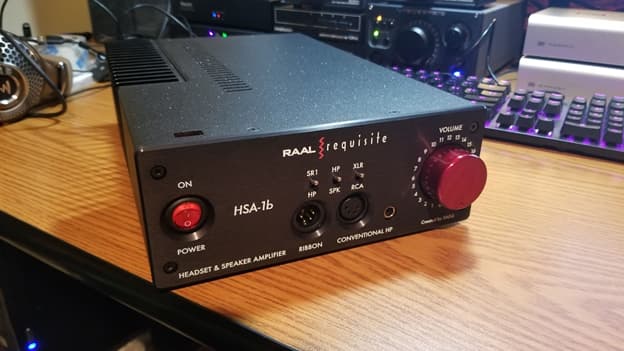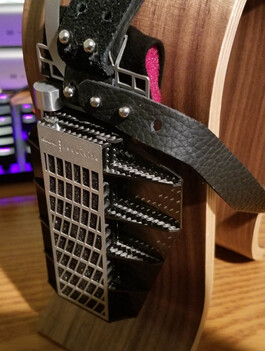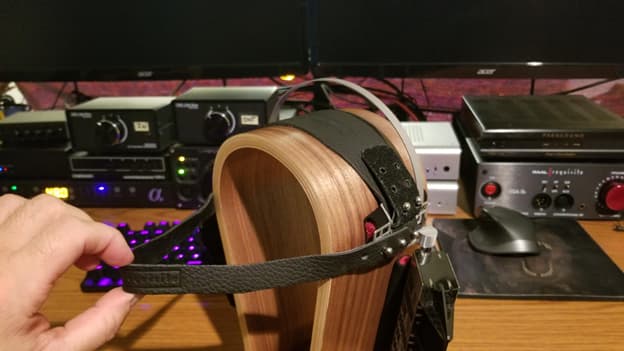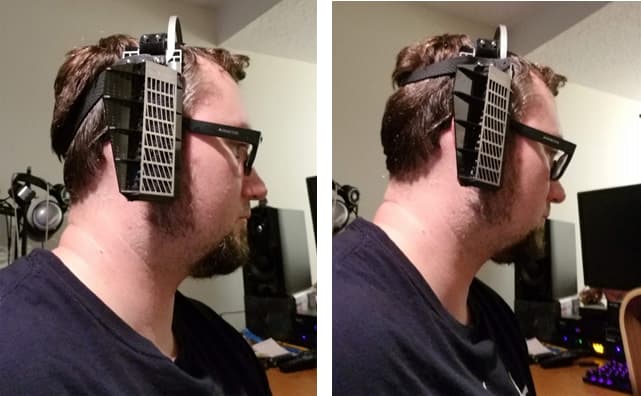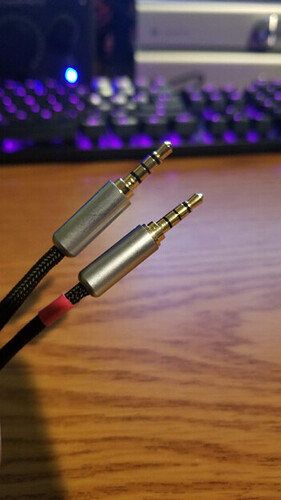INTRODUCTION
The RAAL Requisite SR1a “True Ribbon Earfield Monitor” is a truly interesting product. It is a pair of ribbon speakers strapped to a headband system that creates a near-field – so near it’s ear-field – listening experience, essentially putting a speaker listening experience in a form factor worn like a headphone. If you wish to own access to such an experience it will set you back a minimum of $3500US new, but there are plenty of accessories that have impact on the experience that will add to that cost. We’ll discuss some of those options through the course of this review. I had the privilege of giving this system, with a handful of those fun accessory options, a spin recently so let’s dig into what I found.
TL;DR
The RAAL seems to accomplish what it sets out to do: bring a high-performance, speaker-like listening experience into a headphone-like form factor. There are some ergonomic quirks that can limit its functionality some, but that doesn’t take away from the fact that its sound is amazing. The spatial performance is unlike anything I’ve ever heard from a head-based systems. The detail retrieval and timbre are also utterly fantastic. The bass and dynamic impact will be a bit too-lean for some but as a whole package and with the right music SR1a can be a phenomenal listening experience.
KNOW YOUR REVIEWER
My preferred genres are rock/metal and classical/orchestral music. I’m getting to know jazz more and enjoying quite a bit. I also listen to some EDM and hip-hop. My hearing quirks include a high sensitivity to midrange frequencies from just under 1KHz to around 3Khz, give or take. My ears are thus quick to perceive “shoutiness” in headphones in particular. I describe “shoutiness” as an emphasis on the ‘ou’ sound of ‘shout.’ It’s a forwardness in the neighborhood of 1KHz and/or on the first one or two harmonics above it (when I make the sound ‘ooooowwwww’ into a spectrum analyzer the dominant frequency on the vowel sound is around 930Hz, which also means harmonic spikes occur again at around 1860Hz and 2790Hz). In the extreme, it can have the tonal effect of sounding like a vocalist is speaking or singing through a toilet paper tube or cupping their hands over their mouth. It can also give instruments like piano, but especially brass instruments, an added ‘honk’ to their sound. I also get distracted by sibilance, or sharp ‘s’ and ‘t’ sounds that can make ssssingers sssssound like they’re forssssssing esssss ssssssounds aggresssssssively. Sibilance does not physically hurt my ears nearly as quickly as shout, though. It’s distracting because it’s annoying and unnatural. Finally, I’m discovering that I have a preference for more subtle detail. I like good detail retrieval and hearing what a recording has to offer, but I prefer what many would consider relaxed and subtle rather than aggressive or detail-forward. To my ear, more subtle detail-retrieval sounds more realistic and natural than aggressive, detail-forwardness. There is a balance here, though, because detail retrieval can get too relaxed and that can sound unnatural, as well, or simply leave out important aspects of the recording. Readers should keep these hearing quirks and preferences in mind as they read my descriptions of sound.
FEATURES & BUILD
There is a lot to unpack here. This section will be on the long side. I’ll break it up into smaller chanks as best as possible.
Buying Options
The SR1a, essentially being a pair of ribbon speakers held right next to the ears, is basically a low-impedance speaker. That limits the amplifier options available. RAAL offers several packages with the SR1a that take these amplification needs into consideration. The first is a speaker interface that plugs into the output of a speaker amp:
[pictured with my Adcom GFA-555ii speaker amp]
The speaker interface has a female 4-pin XLR headphone output on the front:
and also includes 4 pair of binding posts on the back panel along with a switch to select between using the SR1a or passing the signal through to a pair of speakers:
The speaker interface also comes with a set of 4 speaker jumper cables (2 pair) to go from your speaker amp into the “Amp In” terminals on the interface. Then, your regular speaker cables connect to the “Spk Out” terminals on the back of the interface. The back panel of the interface claims a nominal impedance load of 6Ω for the interface and SR1a together. RAAL offers the SR1a and speaker interface together in a 3500USD package. My review unit came with this speaker interface.
RAAL also offers the current-drive Schiit Jotunheim R headphone amp with the SR1a.
[image taken from RAAL’s website: https://raalrequisite.com/amplifiers/jotunheim-r/]
The package of SR1a and Jotunheim R costs $4000US from RAAL’s website.
RAAL also makes their own high-end speaker & headphone all-in-one amp known as the HSA-1b:
This amp is rated to deliver up to 40 watts per channel from its speaker output into a 2Ω load. It also has both female and male 4-pin XLR outputs on the front panel for headphone outputs. They are designed to drive the SR1a and regular headphones, respectively. This amp lists for $4500US on its own but RAAL offers it with the SR1a in a package that costs $9000US for the two. Add in the speaker interface box and the entire package is $9500US. This amplifier was sent to me be the same person who sent the headset with amp interface. The amp is an impressive product in its own right and will get its own full review in due time. Stay tuned.
RAAL also offers a plethora of headphone cable options to use with the SR1a. I’ll leave it to their website to explain all of the options (https://raalrequisite.com/ribbon-headphone-cables/). I was able to test with the standard 7-foot version and the $1050 “Studio Reference” 7-foot cable. I will comment on the sonic differences between the cables in the last subsection of the Sound section.
Build
As stated in the introduction, the SR1a is pair of ribbon speakers mounted to a set of straps that allows it to be worn like a headphone. The ribbons themselves are well-made and in a machined aluminum housing:
The design does not enclose the ear. It’s a completely open-baffle system. There is a column of soft foam where the speaker rests against the head to cushion the contact point. This column of foam is meant to sit right in front of the ear. The ribbon assemblies are also on a hinged mechanism that allows them to move from being roughly parallel to the ear to essentially 90 degrees to the side of the head:
These angle adjustments have an impact on the sound, too. When completely closed, the bass has the most presence but the soundstage is the most narrow. When all the way open, the soundstage is the biggest/widest but the bass has the least presence. The swivel uses friction to keep its positioning. There is a fair amount of tightness to make the adjustments. Overall, that’s good because they hold their positions well. There were times when I over-adjusted because of that tightness and had to do some futzing to get things into the right positions.
To hold the ribbon assemblies to the head there is suspension-strap headband system that goes over the head, and a second strap the wraps around being the head:
The straps are of a quality leather and quite soft. The headsize adjustment uses a simple peg-and-hole system:
This system is simple and durable but only allows for coarse adjustments. There is roughly a centimeter between the pegs/holes. If your headsize falls between the adjustment levels, you’ll have to pick between it being just a little bit too loose, or just a little bit too tight. This is more problematic for the around-the-head strap. For my head, I either had to have that strap looping around under the curve of my skull in the back (below left), or get it really tight to hug tightly higher up on the back of my head (below right):
In either case I had a problem with headset sliding around my head a bit, particularly forward. If I were to look down at my desktop while working, the whole assembly would slide forward. It never fell off, but needed readjustment, and would often push my glasses forward as well. The fit seems best for sitting in your lounger, kicking back (but not reclining much), and enjoying the music. The sliding around on the head is just a bit too much for anything else. Because the system does not enclose around the ear like a traditional headphone, there is less friction on the sides of the head to take advantage of, which contributes to it sliding around with movement.
Provided you’re still enough to minimize the sliding, the comfort is actually quite good. The clamp isn’t very tight but also not very loose. I never noticed too much pressure on my jaw. I didn’t notice any hotspots either. The headband straps do a good job of distributing weight. It is a set you could take a nap in, so to speak.
Cabling
The cable entry system is dual-entry with 3.5mm jack on each ribbon. Curiously, the RAAL cables are terminated with 3.5mm TRRS plugs at the headphone end:
Truthfully, I’m not sure why. All the cables have 4-pin XLR connectors on the amp end so there should only be a need for 2 electrical contacts per side. The amp end of each cable is also a female connection. I’m pretty sure that’s done to prevent you from plugging the SR1a into any generic balanced headphone amp and blowing things up.
SOUND
Test Gear
For all testing the source was local FLAC files ranging from 16-bit/44.1-KHz up to 24-bit/192-KHz, local DSD files, and streamed FLAC (same bit rates) from Qobuz, all using Audirvana 3.5. On my desktop system the PC was connected to a Singxer SU-2 USB bridge then an AES connection to a Berkeley Alpha S2 DAC. The RAAL HSA-1b carried amp duties on this chain. The other chain used the same PC but then streamed all the same filetypes over my local network to an iFi Zen Stream. The Zen Stream was connected via an Audioquest Forest USB cable to a Chord Hugo 2. The RCA outputs of the Hugo 2 fed an original Schiit Saga preamp which in turn connected to an Adcom GFA-555ii speaker amp. RAAL’s speaker amp interface box then connected the amp to the SR1a. I also did some listening by using the Saga’s second pair of RCA outputs and feeding my Polk PSW-505 subwoofer to get a feel for what using the SR1a with a sub would be like. I used the higher quality Studio Reference cable for most of my listening tests, until I set out to see if I could hear differences between the cables.
Presentation
I’m going to do a subsection just about presentation because of the unique-ness of this product. It really does sound like speakers. The imaging is mostly out-in-front as it is with speakers. However, the room reflections are essentially eliminated so the challenge of speaker placement doesn’t come along for the ride. But, over and over again, listening to the SR1a reminded me of listening to speakers that just happened to be close to my head.
Sound Signature
I ended up landing with the ribbons angled at about 45 degrees to the plane of the side of my head most of the time. Here the signature was somewhat bright with more emphasis on the treble than on the bass. The bass gains a bit more presence the closer the ribbons get to being closed, but these are never going to be bass monsters. In fact, there is a fairly aggressive roll-off in the subbass below 60Hz with very little going on in the deep subbass. This roll-off becomes particularly noticeable in a track like “Mountains” from the Interstellar soundtrack. The descending bass that happens following the large brass swells doesn’t muster much in its lowest reaches. However, above that point the bass presence seems in line with the mid-range presence, with the treble being just a little bit higher yet, although not by much. The brightness in the signature is also quite smooth. So while it’s a brighter sound, it never came across to me as sharp or piercing. There is great balance between being sparkly and being controlled in the top end.
Resolution
Um, wow. The only other piece of audio gear I’ve heard that challenges the detail retrieval ability of the SR1a is the Abyss Diana Phi. I haven’t had the chance to hear those in direct comparison, but the levels of detail I heard from the 1a reminded me of the Diana Phi…EXCEPT that the 1a was much more relaxed in its detail presentation. Basically, everything is there. Room reverbs, the initial strikes on cymbals followed by the tone, texturing, the zizzy sound of bows on strings…it’s all present and never forced. The way it’s presented is very natural but still easily audible.
Spatial Presentation
Beyond being speaker-like, I flat out haven’t heard soundstaging, imaging, separation, or depth layering of this level before. For me this is the new standard. There is amazing accuracy is where instruments are placed to go with a convincingly realistic since of space between them. The listening space is also rendered well. In live recordings like classical or orchestral works where there is a stage, that sound from that stage is reproduced quite believable with excellent spatial accuracy, but there is also a convincing since of space beyond that stage. In other words, the SR1a is a strong in reproducing room sounds and transporting a listener to a concert hall or arena.
Timbre
For the most part, voices and instruments sound like excellent reproductions of what they sound like in the real life. In other words, the timbre is excellent. I didn’t notice in shoutiness or honkiness in the mids – which I am prone to hearing. If I had to nitpick I would say that some bass instruments sounded a little thin because the subbass roll-off reduced the presence of some of the lower harmonics, but outside of that the timbre is another true strength of the SR1a.
Macro- and Microdynamics
Let’s first differentiate between these two terms. Macrodynamics refers to the ability to punch, slam, hit, or “slap”. It’s the physicality and impact of the sound. Microdynamics are the small changes in volume and the ability to resolve small changes in sound intensity. Resolving these small changes well help with things like texture. The SR1a is a strong performer in microdynamics. The sound is very textured. This microdynamic prowess also contributes to it sounding very high in resolution as textures are pulled out beautifully. The SR1a is not a particularly macrodynamic piece, though. There is a lot of speed to the sound. The mids and highs reach quickly and clearly. Yet to me, they aren’t impactful. If you’re a listener who enjoys the punch and physicality of brands like Abyss, Fostex, Focal, or to a slightly-lesser-extent Audeze, the SR1a is likely not the headphone for you – or at least not a candidate to be your primary headphone.
Supplementing with a Subwoofer
I mentioned running the SR1a off my speaker amp and using subwoofer with it above. I’ve heard of some people enjoying listening to headphones/earspeakers with a sub, and I’ve long been skeptical of its efficacy. Why? Phasing. It always seemed like it would be really hard to correct for the time misalignment by having transducers for the mids and highs right by the ears and then the bass transducer some number of feet or meters away. What bass the headphone produced would reach the ear earlier, and in situations where a bass tone lasted long enough that both the headphone’s low end and the sub’s delayed wavefront could be heard simultaneously, there would most likely be some wave interference changing the shape of the waveform from what was in the recording. Even with an effective crossover, there are also concerns like the higher pitched sounds of the mallet of a bass drum hitting the skin reaching the ear first and then a delay before the weight of the low tone arrived. So…I put the SR1a on and got as close to my sub driver as I possibly could. Now that became a very macrodynamic experience, hahaha. It took some tweaking to get to a subwoofer volume level that didn’t seem crazy out-of-line with the loudness of the SR1a. Once I got that done, there were a few tracks where I could hear some phasing oddities in the 80ish-100ish Hz range. Mostly, that sounded like a bit of tonal fluttering – not driver fluttering – that was likely the effect of wave interference creating to maxima in and minima in the waveform. They sounded a lot like the beats once listens for when tuning a guitar or piano. The SR1a is still giving noticeable information down at least that low, rolling off mostly below 60 Hz, it seems. I set my sub’s crossover to 60 Hz (its lowest setting) and I didn’t hear that fluttering those phasing issues were producing on the same tracks I had noticed it previously. With all that done, I settled in for some punchier, more dynamic music, and some music that needs crazy subbass reproduction. It was readily apparent that my poor Polk subwoofer (my 2 channel system is nowhere near up to the same caliber as my headphone gear…yet) is not on the same performance level as the SR1a. From high frequencies to low, the experience was like detail detail detail detail BOOM! Even so, it was an overall enjoyable experience and worked well as a proof of concept. “Gypsy” by Fleetwood Mac sounded great. Ditto on “The Less I Know the Better” by Tame Impala. The SR1a with the subwoofer became a much more dynamic, punchy, engaging experience with that kind of music. Grandiose pipe organ music also became fuller and more captivating. Toccata & Fugue in D Minor (AKA the Dracula theme) by Bach and played by Peter Hurford was nothing short of awe inspiring. It sounded enormous and the sub brought the subbass rumble and feeling the SR1a couldn’t provide on its own. Together they created a listening experience that rivaled a huge 2.1 channel system. Now, the Hugo 2 + Saga + GFA-555ii signal chain was not as resolving or spatially coherent as the Alpha S2 + HAS-1b on the desktop chain either, but I’m more comfortable saying now that with enough tweaking and a phase dial on higher quality subwoofer (rather than just a 0 or 180 phase switch) the SR1a and that subwoofer could create an amazing listening experience that many will find truly compelling.
Funny story though…after playing around with the SR1a and sub together and emerging from my basement listening room to see the rest of the family I got lots of strange looks. Eventually one of the kids said “Why just the bass this time? Where was the rest of the music?” Yeah, it needs to be said that using a subwoofer with a head-based listening system does defeat one of the advantages a head-based system brings: more privacy and less interference with the world around you.
Amp Pairings
I touched on this briefly in the preceding section. The SR1a still sounded quite awesome on my signal chain with the GFA-555ii amp. It was not quite as clear or clean and the staging wasn’t quite as cohesive and convincing as the desktop chain with the HSA-1b. Still, it was very impressive and among the best I’ve heard from a head-based system so far. The performance on this amp suggests to me that if you already have a speaker amp that you like and is reasonably powerful, the $3500 option for the headset and speaker adapter box is quite a deal. What I didn’t try as it would require a lot of reshuffling and then waiting for things to warm up again, is using my Berkeley DAC with the Adcom speaker amp. So, some of the performance loss is from the desktop chain is likely due to using the Hugo 2 as the DAC. Still, the Hugo 2 is no slouch as a DAC and it bears repeating that the speaker-amp system still sounded wonderful through the SR1a.
Music Matches
Without a subwoofer the SR1a is at its best when playing music that doesn’t rely much on active dynamics or subbass presence. This includes a lot of classical, chamber music, smooth jazz, some folk music, etc. Where it doesn’t work as well, at least for me, is with the bigger and more bombastic classical works (think Beethoven’s 5th or 1812 Overture here) and rock, metal, hip-hop, EDM, etc. That’s mostly because it just doesn’t have the subbass presence or impact that make a lot of those genres work. It’s not that it sounds bad – the detail retrieval and staging and timbre are all there doing a great job – it’s just a case of not being able to deliver that thick, bass-heavy sound that often defines those genres. Some may still love these genres on the SR1a because the bass isn’t as important to them. I can understand that. I’ll just say that for music of that type, I prefer something else.
Add in a subwoofer and things change quite a bit, though. Even though I don’t have subwoofer that’s anywhere near the quality level of the SR1a nor was I able to get it dialed in perfectly with phasing and crossover and all that, I got enough of a glimpse into it to realize that pairing the SR1a fleshes out the missing parts of the lower regions and adds in that punchy physicality and impact that hard rock, metal, hip-hop, and EDM need.
Cables Matter
OK, venturing into controversial territory here. Does the $1050 silver Studio Reference cable make a difference? Yes. Is that difference worth the $1050? Nice try. I can’t answer that for you. I got the sense that both cables were quite good, although differences and the fact that one was clearly higher performing than the other were detectable. The Studio Reference cable had a darker sonic background, an overall cleaner sound, presented more microdetail, and enhanced the spatial presentation. The separation between sonic images within that spatial presentation was a particular point where the Studio Reference outperformed the stock cable. On the whole, the Studio Reference cable created a more convincing, lifelike sound than the stock cable. The overall sound signatures were also ever-so-slightly different. To the extent the SR1a can reproduce subbass, the Studio Reference cable had more of it and a little bit more treble extension. The stock cable had a slight emphasis on the frequencies in the warmth range which gave it a slightly warmer overall character. Some listeners might prefer that signature, but it’s quite clear, at least to my ears, that the Studio Reference cable is the all-around superior cable on a technical level.
COMPARISONS WITH OTHER HEAPHONES(?), EARSPEAKERS(?), LISTENING GIZMOS
This gets tough because the SR1a is in a very small class of products. The Mysphere 3 is the only other “floating ear-speaker” kind of thing I can think of and I haven’t had the opportunity to hear that yet. I’ve heard a number of headphones in the $3000-4000 range lately, though. Those include HiFiMan HE-1000v2, Focal Stellia, Audeze LCD-24, Abyss Diana Phi, and Meze Empyrean Elite.
The SR1a has a more speaker-like presentation than any of those headphones. The HE-1000v2 and Meze Elite are probably the next most speaker-like, but they don’t catch the SR1a in that regard. The spatial presentation on the SR1a is the most realistic and coherent of the group, to my ear, as well. The HE-1000v2 is probably the next best on this list in this category, but clearly behind SR1a. The HE-1000v2 also brings warmth and subbass presence much more than the SR1a. The Elite can do similarly with its hybrid pads but not as much with its velour pads. The Diana Phi is the only headphone I’ve heard to date that could compete with the SR1a on pure resolution. I can’t say which is more resolving as I didn’t have them at the same time. My guess is they’re very close. The Diana Phi is more detail-forward though, seemingly emphasizing its resolution prowess at times. The SR1a is smoother and more natural in its detail presentation. The SR1a also has far more natural timbre than the Diana Phi, to my ear. All of the headphones named above also have a more macrodynamic presentation than the SR1a. Some of them (Stellia, Diana Phi) are very punchy and physical. Some are more in the middle (LCD-24, HE1000v2, Elite), but they all have more dynamic impact than SR1a by some distance.
USE CASES
I’ve already discussed what kinds of music I think work best with the SR1a above. I’ll add brief comments here about use cases I think make sense for SR1a. If the listening goals are to have a speaker-like experience and remove the effects of the room, it’s a strong option. If you’re primarily a 2-channel listener and a fan of music that isn’t predicated on a lot of bass energy and need a family-friendly late-night listening solution or you’ve moved from a house to an apartment, the SR1a is an excellent option. That it can be driven from a speaker amplifier at the flick of a switch increases the attractiveness of this option. The SR1a is an excellent switch-up to a 2-channel system that brings with it some of the ergonomic and privacy benefits of headphones. In this case, ‘privacy’ means the sound will stay contained within an apartment unit or a room with the door closed – the completely open nature still means anyone in the room with you is going to hear pretty much everything.
The SR1a’s sound is till more speaker-like than headphone-like. Headphones have a spatial presentation that is different and that can be desirable in some situations. Also closed-back headphones offer a level of isolation that is attractive is some situations. Then, there is the lack of subbass presence with the SR1a. The only way to recover that is to use a subwoofer and that removes one of the key advantages to head-based systems. All of these factors should be weighed if you’re considering the SR1a.
FINAL THOUGHTS
Whew! That was a lot of words. But there’s a lot to talk about with a product as unusual as the SR1a. It provides a speaker-like listening experience that’s worn like a headphone. It brings exquisite resolution, excellent timbre, and price-level-leading spatial performance to the table. It’s a bit lean in the subbass and not the most macrodynamic listening experience, which makes it more suited to music genres where heavy bass presence is essential to the experience. However, if the former is the kind of music you enjoy, and you want a speaker-like presentation that removes room limitations, the SR1a is an absolute must-audition for you.
Thanks for reading all! Enjoy the music!
![]()

